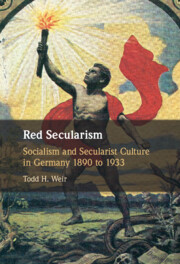Book contents
- Red Secularism
- Red Secularism
- Copyright page
- Contents
- Figures
- Tables
- Preface
- Abbreviations
- 1 Introducing Socialism and Secularism as Two Cultures
- 2 Secularist Culture in an Industrializing City
- 3 Prometheans
- 4 The Sociology and Psychology of Secularist Intellectuals
- 5 Workers and Worldview
- 6 The Politics of Secularism 1905–1914
- 7 Secularists in War and Revolution 1914–1922
- 8 Monism in the Weimar Workers’ Culture Movement
- 9 Culture War at the End of the Weimar Republic
- Epilogue
- Appendixes
- Archives Used
- Index
5 - Workers and Worldview
Published online by Cambridge University Press: 30 November 2023
- Red Secularism
- Red Secularism
- Copyright page
- Contents
- Figures
- Tables
- Preface
- Abbreviations
- 1 Introducing Socialism and Secularism as Two Cultures
- 2 Secularist Culture in an Industrializing City
- 3 Prometheans
- 4 The Sociology and Psychology of Secularist Intellectuals
- 5 Workers and Worldview
- 6 The Politics of Secularism 1905–1914
- 7 Secularists in War and Revolution 1914–1922
- 8 Monism in the Weimar Workers’ Culture Movement
- 9 Culture War at the End of the Weimar Republic
- Epilogue
- Appendixes
- Archives Used
- Index
Summary
The socialist movement had two worldviews, monist materialism a la Ludwig Büchner and dialectical materialism a la Karl Marx. This chapter examines how party leaders and secularist intellectuals theorized the relationship of the two and then looks at the role of popular science in party educational policy. It then moves from the theoretical and policy level to an investigation of the intellectual world of rank-and-file socialists. It opens up new perspectives to explain the well-established fact that workers more happily read works of scientific materialism than the works of Kautsky or Marx. Autobiographical texts are examined to understand why conversion experiences were usually tied to the acceptance of scientific rather than historical materialism. It introduces the role of secularism in the biographies of important socialist leaders, such as Walter Ulbricht, the future leader of the GDR (1949-71). Based on the growing realization that many social groups organized in socialism were attracted to secularist worldview, the chapter will also look at the women’s movement inside the SPD and its particular take on monism.
Keywords
- Type
- Chapter
- Information
- Red SecularismSocialism and Secularist Culture in Germany 1890 to 1933, pp. 114 - 152Publisher: Cambridge University PressPrint publication year: 2023

